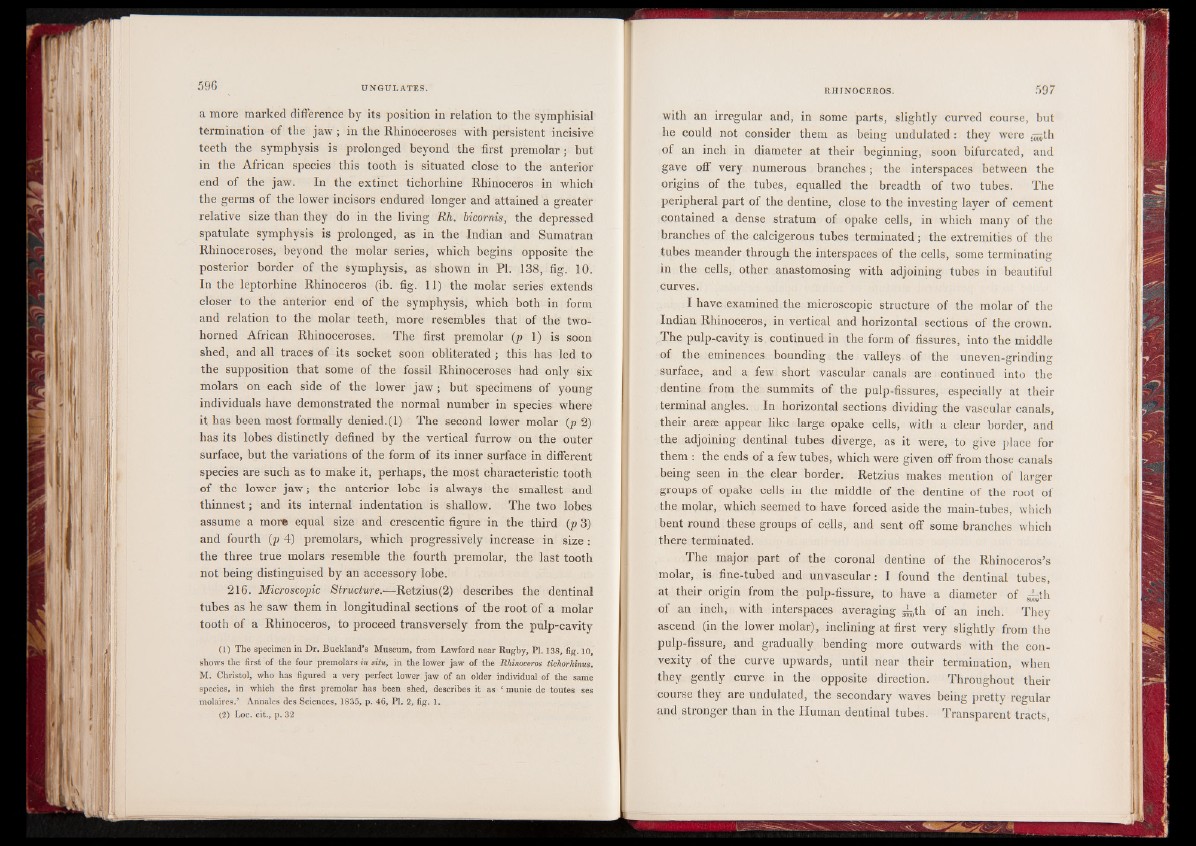
a more marked difference by its position in relation to the symphisial
termination of the jaw ; in the Rhinoceroses with persistent incisive
teeth the symphysis is prolonged beyond the first premolar; but
in the African species this tooth is situated close to the anterior
end of the jaw. In the extinct tichorhine Rhinoceros in which
the germs of the lower incisors endured longer and attained a greater
relative size than they do in the living Rh. bicornis, the depressed
spatulate symphysis is prolonged, as in the Indian and Sumatran
Rhinoceroses, beyond the molar series, which begins opposite the
posterior border of the symphysis, as shown in PI. 138, fig. 10.
In the leptorhine Rhinoceros (ib. fig. 11) the molar series extends
closer to the anterior end of the symphysis, which both in form
and relation to the molar teeth, more resembles that of the twohorned
African Rhinoceroses. The first premolar (p 1) is soon
shed, and all traces of -its socket soon obliterated ; this has led to
the supposition that some of the fossil Rhinoceroses had only six
molars on each side of the lower jaw ; but specimens of young
individuals have demonstrated the normal number in species where
it has been most formally denied.(1) The second lower molar (p 2)
has its lobes distinctly defined by the vertical furrow on the outer
surface, but the variations of the form of its inner surface in different
species are such as to make it, perhaps, the most characteristic tooth
of the lower jaw; the anterior lobe is always the smallest and
thinnest; and its internal indentation is shallow. The two lobes
assume a more equal size and crescentic figure in the third (p 3)
and fourth (p 4) premolars, which progressively increase in size :
the three true molars resemble the fourth premolar, the last tooth
not being distinguised by an accessory lobe.
216. Microscopic Structure.—Retzius(2) describes the dentinal
tubes as he saw them in longitudinal sections of the root of a molar
tooth of a Rhinoceros, to proceed transversely from the pulp-cavity
(1) The specimen in Dr. Buckland’s Museum, from Lawford near Rugby, PI. 138, fig. 10,
shows the first of the four premolars in situ, in the lower jaw of the Rhinoceros tichorhinus.
M. Christol, who has figured a very perfect lower jaw of an older individual of the same
species, in which the first premolar has been shed, describes it as ‘ munie de toutes ses
molaires/ Annales des Sciences, 1835, p. 46, PI. 2, fig. 1.
(2) Loc. cit., p. 32
with an irregular and, in some parts, slightly curved course, but
he could not consider them as being undulated : they were g^th
of an inch in diameter at their beginning, soon bifurcated, and
gave off very numerous branches; the interspaces between the
origins of the tubes, equalled the breadth of two tubes. The
peripheral part of the dentine, close to the investing layer of cement
contained a dense stratum of opake cells, in which many of the
branches of the calcigerous tubes terminated; the extremities of the
tubes meander through the interspaces of the cells, some terminating
in the cells, other anastomosing with adjoining tubes in beautiful
curves.
I have examined the microscopic structure of the molar of the
Indian Rhinoceros, in vertical and horizontal sections of the crown.
The pulp-cavity is continued in the form of fissures, into the middle
of the eminences bounding the valleys of the uneven-grinding
surface, and a few short vascular canals are continued into the
dentine from the summits of the pulp-fissures, especially at their
terminal angles. In horizontal sections dividing the vascular canals,
their arese appear like large opake cells, with a clear border, and
the adjoining dentinal tubes diverge, as it were, to give place for
them : the ends of a few tubes, which were given off from those canals
being seen in the clear border. Retzius makes mention of larger
groups of opake cells in the middle of the dentine of the root of
the molar, which seemed to have forced aside the main-tubes, which
bent round these groups of cells, and sent off some branches which
there terminated.
The major part of the coronal dentine of the Rhinoceros’s
molar, is fine-tubed and unvascular: I found the dentinal tubes,
at their origin from the pulp-fissure, to have a diameter of ^ th
of an inch, with interspaces averaging ^ th of an inch. They
ascend (in the lower molar), inclining at first very slightly from the
pulp-fissure, and gradually bending more outwards with the convexity
of the curve upwards, until near their termination, when
they gently curve in the opposite direction. Throughout their
course they are undulated, the secondary waves being pretty regular
and stronger than in the Human dentinal tubes. Transparent tracts,